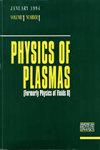Efficient laser-driven proton acceleration from a petawatt contrast-enhanced second harmonic mixed-glass laser system
IF 2.2
3区 物理与天体物理
Q3 PHYSICS, FLUIDS & PLASMAS
引用次数: 0
Abstract
Efficient laser-driven plasma acceleration of ion beams requires precision control of the target–plasma profile, which is crucial to optimize the laser energy transfer. Along the laser propagation direction, this can be achieved by tailoring the temporal structure of the laser pulse. We show for the first time that frequency-doubling of a short pulse (hundreds-femtosecond range) petawatt-class mixed-glass laser system, which results in temporal intensity contrast enhancement, enables surface and volumetric laser–energy coupling, and the acceleration of proton beams from few-nanometer-thick foil targets. Experimentally, maximum ion energies and laser-to-proton energy conversion efficiencies were found to be both maximized at optimum laser and target conditions manifested when the normalized target density nearly equalizes the normalized laser vector potential, which is in agreement with theory and simulations. These signatures are recognized as a unique indication of the interaction between ultra-intense laser pulses with high temporal intensity contrast and ultra-thin nanometer-scale targets. Transverse modulations of accelerated proton beams in the form of bubble- and ring-like structures measured in the thinnest targets provide additional evidence of volumetric laser-driven particle acceleration regimes and transitional features in ultra-thin foil targets specific to laser–plasma interactions characterized by a high temporal intensity contrast. These results open avenues in the generation of high contrast laser pulses from short-pulse-femtosecond petawatt mixed-glass laser systems and demonstrate the feasibility of this technique for applications requiring high laser intensity contrast with high efficiency.兆瓦级对比度增强型二次谐波混合玻璃激光系统的高效激光驱动质子加速度
要实现离子束的高效激光驱动等离子体加速,就必须精确控制目标-等离子体剖面,这对于优化激光能量传递至关重要。沿着激光的传播方向,可以通过调整激光脉冲的时间结构来实现这一目标。我们首次展示了短脉冲(数百毫微秒范围)小功率级混合玻璃激光系统的频率加倍,从而增强了时间强度对比度,实现了表面和体积激光能量耦合,并加速了来自几纳米厚的箔靶的质子束。实验发现,当归一化目标密度几乎等于归一化激光矢量势时,在最佳激光和目标条件下,最大离子能量和激光-质子能量转换效率均达到最大值,这与理论和模拟结果一致。这些特征被认为是具有高时间强度对比的超强激光脉冲与超薄纳米级靶之间相互作用的独特迹象。在最薄靶材中测量到的气泡和环状结构形式的加速质子束横向调制,为激光驱动的粒子体积加速机制提供了更多证据,也为以高时间强度对比为特征的激光-等离子体相互作用所特有的超薄箔靶中的过渡特征提供了更多证据。这些结果为从短脉冲-飞秒 petawatt 混合玻璃激光系统中产生高对比度激光脉冲开辟了道路,并证明了这种技术在需要高激光强度对比度和高效率的应用中的可行性。
本文章由计算机程序翻译,如有差异,请以英文原文为准。
求助全文
约1分钟内获得全文
求助全文
来源期刊

Physics of Plasmas
物理-物理:流体与等离子体
CiteScore
4.10
自引率
22.70%
发文量
653
审稿时长
2.5 months
期刊介绍:
Physics of Plasmas (PoP), published by AIP Publishing in cooperation with the APS Division of Plasma Physics, is committed to the publication of original research in all areas of experimental and theoretical plasma physics. PoP publishes comprehensive and in-depth review manuscripts covering important areas of study and Special Topics highlighting new and cutting-edge developments in plasma physics. Every year a special issue publishes the invited and review papers from the most recent meeting of the APS Division of Plasma Physics. PoP covers a broad range of important research in this dynamic field, including:
-Basic plasma phenomena, waves, instabilities
-Nonlinear phenomena, turbulence, transport
-Magnetically confined plasmas, heating, confinement
-Inertially confined plasmas, high-energy density plasma science, warm dense matter
-Ionospheric, solar-system, and astrophysical plasmas
-Lasers, particle beams, accelerators, radiation generation
-Radiation emission, absorption, and transport
-Low-temperature plasmas, plasma applications, plasma sources, sheaths
-Dusty plasmas
 求助内容:
求助内容: 应助结果提醒方式:
应助结果提醒方式:


